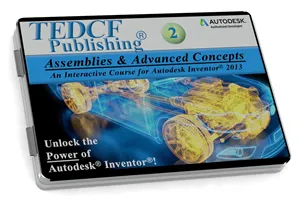Unlock the Power of Autodesk Inventor 2013!
The Inventor 2013: Assemblies and Advanced Concept course is designed to expand your part modeling skills, establish a strong assembly design process, and show you best practices. You will learn all the details of creating and using derived parts, iParts and iFeatures, the Design Accelerator, and much more while employing Top Down, Middle Out, and Bottom Up design strategies. The course shows you real life problems and the steps to avoid or resolve these issues. Complex concepts are also broken down into easy to understand steps. As a result, your models will be accurate and easy to edit.
91 Lessons (Listed Below)
9.5 hours of instruction
You can also browse through the lessons from the following Inventor 2013 courses and watch sample lessons.
Inventor 2013: Solid Modeling Inventor 2013: Assemblies and Advanced Concepts Inventor 2013: 2D Drafting and Customization Inventor 2013: Sheet Metal Design Inventor 2013: Tube and Pipe Routed Systems Inventor 2013: Inventor Studio Made Simple Inventor 2013: iLogic Made SimpleOur Inventor courses require No Installation. You can watch them on any device connected to the internet.
You will receive an email containing your User Name and Password. Login to your account and start learning. It's that easy.
While you're logged into your account you can download files used in the courses, watch lessons, and practice the tasks taught in the lessons. Keep in mind that you will use your installation of Inventor to practice.
Get your Inventor 2013 training now. You can start learning in minutes.
Autodesk Inventor® 2013:
Assemblies and Advanced Concepts
No Installation Required
Watch from any device connected to the internet.

$54.95 - $109.95
Watch Sample Lessons
Watch the first hour of the Solid Modeling course for Autodesk Inventor 2013.
 Click to Watch!
Click to Watch!Assemblies and Advanced Concept
9.5 hours of instruction
Lessons
Introduction
Sketch Origin Node
Using and Creating Templates
Creating Derived Parts
Editing Derived Parts
Intro to the Assy Environment
Degrees of Freedom
Driving Constraints
Explicit Reference Vectors
Adaptive Parts and Sketches
Adaptive Constraint Strategies
Creating Adaptive Parts I
Creating Adaptive Parts II
Using Constraint Strategies
Removing Adaptivity
Driving Adaptive Assemblies
The Content Center
Mirrored Assemblies
Mirrored and Copied Constraints
Flexible Assemblies
Copied Assemblies
Pattern Components
Advanced Viewing
Assembly Viewing
Motion Constraints
Animating Gears
Transitional Constraints
Collision Detection
Contact Solver
Checking for Interferences
Creating Compressible Springs
Driving Adaptive Springs
Positional Representations
Creating Presentations
Editing Tweaks
Animating Presentations
iFeature Design
Inserting iFeatures
Reusing Part Features
Advanced iFeature Design
Reducing Dangling Geometry
Creating iPart Factories
iPart Members
Editing the iPart Author
iMates and iParts
Custom iParts
Creating iPart Assemblies
Updating iParts
Threaded iParts
iMates and the Content Center
Identifying and Using iMate Glyphs
Inferred iMates
Scaling Parts
Combining Parts I
Combining Parts II
Subtracting and Splitting Parts
Deleting Faces
Strategy for Splitting Parts
Trick for Measuring Interferences
Prep for Design Accelerator
Bolted Connections
Generating Bearings
Generating Shafts Part I
Generating Shafts Part II
Generating Shafts Part III
Generating Gears
Generating Keyways
Advanced Spring Design I
Advanced Spring Design II
Animating Springs
Resolving Missing Files
Working with Large Assemblies
Level of Detail
Shrinkwrapping Components
Skeletal Modeling Introduction
Make Part and Components
Kinematics
Sketch Blocks
Advanced Top Down Design
Blocks and Assemblies
Modeling Techniques I
Modeling Techniques II
Flexible Block Assemblies
Hybrid Design Methods
Alternate Slice Method
Import Assy to Part File
Middle Out Design
Exporting Bodies to an Assembly
Replacing Assemblies
The Assemble Command
Conclusion
